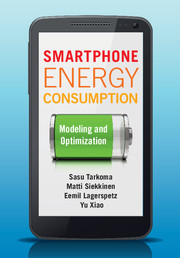Book contents
- Frontmatter
- Contents
- Preface
- List of abbreviations
- Part I Understanding energy consumption
- Part II Energy management and conservation
- 6 Overview
- 7 Smartphone subsystems
- 8 Mobile operating systems
- 9 Power modeling
- 10 Power profilers
- Part III Advanced energy optimization
- Appendix A An energy profile application
- Index
- References
8 - Mobile operating systems
from Part II - Energy management and conservation
Published online by Cambridge University Press: 05 August 2014
- Frontmatter
- Contents
- Preface
- List of abbreviations
- Part I Understanding energy consumption
- Part II Energy management and conservation
- 6 Overview
- 7 Smartphone subsystems
- 8 Mobile operating systems
- 9 Power modeling
- 10 Power profilers
- Part III Advanced energy optimization
- Appendix A An energy profile application
- Index
- References
Summary
Mobile operating systems are a relatively new development in the computing world. Mostly they are based on some existing older OS, typically written for stationary computers and laptops. For example, Android is based on the Linux kernel, iOS on the Mac OS X kernel, and Windows Phone on the Windows NT kernel. The mobile OS borrows many features from the desktop world; however, it needs to meet the demands of the mobile environment for communication needs, positioning of the device, power challenges caused by mobile operation with rechargeable batteries, and smaller size for the convenience and comfort of users. The OS is responsible for overseeing and managing the hardware and software components on the smartphone and it is responsible for the system-level power management.
In this chapter, we examine four current state-of-the-art smartphone OSs – iOS, Windows Phone, Firefox OS, and Android – as well as a number of energy-conserving research prototypes. We focus on the current generation of mobile OSs given our focus on smartphones. Classical examples of earlier feature phone OSs include the Symbian OS and Windows Mobile [1]. After examining the four smartphone OSs, we compare their features and properties.
Overview
Power management is an integral part of an OS that operates on multiple levels from drivers to applications. As the functionalities and features of mobile devices are constantly growing so is the demand for power.
Information
- Type
- Chapter
- Information
- Smartphone Energy ConsumptionModeling and Optimization, pp. 137 - 161Publisher: Cambridge University PressPrint publication year: 2014
References
Accessibility standard: Unknown
Why this information is here
This section outlines the accessibility features of this content - including support for screen readers, full keyboard navigation and high-contrast display options. This may not be relevant for you.Accessibility Information
- 1
- Cited by
